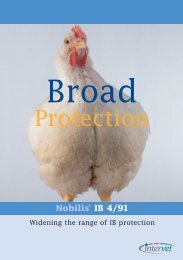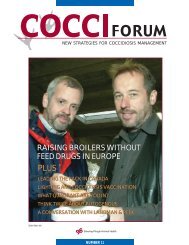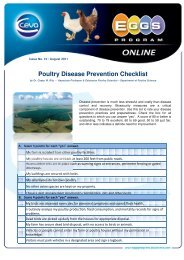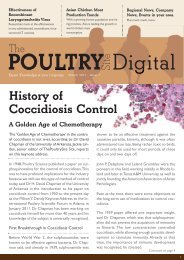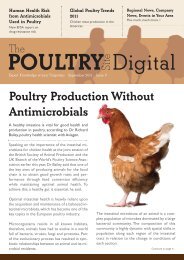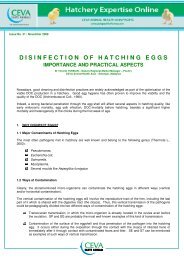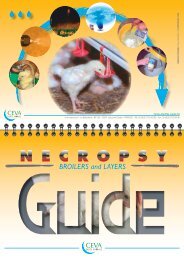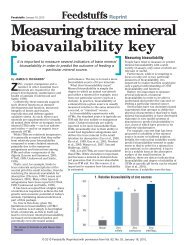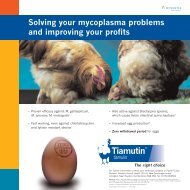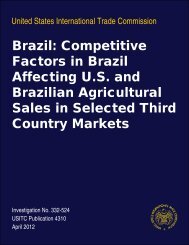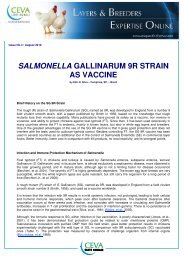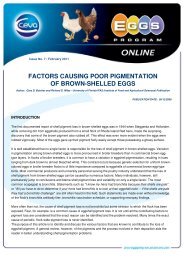Global Market Analysis - The Poultry Site
Global Market Analysis - The Poultry Site
Global Market Analysis - The Poultry Site
You also want an ePaper? Increase the reach of your titles
YUMPU automatically turns print PDFs into web optimized ePapers that Google loves.
How to Produce More<br />
Quality Turkey Poults<br />
Breeder body weight management<br />
& optimising incubation<br />
<strong>Global</strong> <strong>Market</strong><br />
<strong>Analysis</strong><br />
FAO’s forecast for poultry meat<br />
production in 2011<br />
Regional News, Company<br />
News, Events in Your Area<br />
Plus much, much more..!<br />
<strong>The</strong><br />
POULTRY Digital<br />
<strong>Site</strong><br />
Expert Knowledge at your Fingertips<br />
July 2011 - Issue 7<br />
Challenges of Supplying Quality<br />
Turkey Meat to Meet <strong>Global</strong><br />
Demand for Food<br />
A look at past, present and future supply<br />
and demand of turkey meat by Richard<br />
Hutchinson of Aviagen Turkeys. Jackie<br />
Linden, senior editor of <strong>The</strong><strong>Poultry</strong><strong>Site</strong>,<br />
reports from the Temperton Fellowship<br />
presentation in London in June 2011.<br />
<strong>The</strong> turkey business may have changed since<br />
Richard Hutchinson started his career in turkey<br />
production 35 years ago but, now having reached<br />
the position of Director for Sales and <strong>Market</strong>ing<br />
at Aviagen Turkeys, he continues to look forward<br />
with optimism. He opened his presentation to the<br />
Temperton Fellowship saying: "I see many opportunities<br />
for turkey meat going forward."<br />
BACKGROUND<br />
Originally, the turkey market in the UK centred<br />
on whole birds for the Christmas and Easter markets,<br />
and for Thanksgiving in the US. In the mid-<br />
1970s, it was Italy that dominated turkey<br />
production in Europe but the US led the way for<br />
the industry, Mr Hutchinson said.<br />
Continued on page 4...<br />
1
July 2011 - Issue 7<br />
Expert Knowledge at your Fingertips<br />
01<br />
Challenges of Supplying Quality Turkey<br />
Meat to Meet <strong>Global</strong> Demand for Food<br />
A look at past, present and future supply and demand of turkey<br />
meat by Richard Hutchinson of Aviagen Turkeys. Jackie Linden, senior<br />
editor of <strong>The</strong><strong>Poultry</strong><strong>Site</strong>, reports from the Temperton Fellowship<br />
presentation in London in June 2011. Page 1<br />
Food Outlook <strong>Global</strong><br />
<strong>Market</strong> <strong>Analysis</strong><br />
June 2011<br />
A resurgence of avian influenza<br />
and high feed prices may halve<br />
poultry meat output growth, according<br />
to the latest Food Outlook<br />
report from the UN Food<br />
and Agriculture Organization<br />
(FAO). Page 8<br />
How to Produce<br />
More Quality Poults<br />
For more quality poults, it is<br />
necessary to optimise both egg<br />
production and hatchability,<br />
writes senior editor, Jackie Linden.<br />
Page 14<br />
03<br />
16<br />
26<br />
Edito rial<br />
A word from the Editor<br />
A Reappraisal of the Potential of Dietary Fatty Acids to Ameliorate<br />
Heat Stress<br />
<strong>The</strong> strategic use of new oil seed varieties high in oleic acid may ameliorate the adverse effects of heat stress<br />
in poultry, according to P.J. Cronjé of Cronjé Consulting and Editing at the 2011 Australian <strong>Poultry</strong> Science<br />
Symposium.<br />
Regional News<br />
<strong>The</strong> latest news from the Americas, Europe, Asia, Africa and Oceania<br />
30 Events<br />
Keep up to date with what is happening in the global poultry industry.<br />
32 Company News<br />
News from our advertisers<br />
Get in Touch!<br />
For Editorial Enquiries:<br />
Jackie Linden<br />
jackie.linden@5mpublishing.com<br />
Tel: +44 (0) 1234 818180<br />
For Advertising Enquiries:<br />
Alex Guy<br />
Alex.guy@5mpublishing.com<br />
Tel: +44 (0) 1234 818180<br />
2
Editorial<br />
Welcome to <strong>The</strong><strong>Poultry</strong><strong>Site</strong> Digital Issue 7<br />
Turning to Turkeys<br />
In this issue of <strong>The</strong><strong>Poultry</strong><strong>Site</strong> Digital, we turn our<br />
attention to turkey production.<br />
Having spent his whole career in the turkey business,<br />
Richard Hutchinson of Aviagen Turkeys was<br />
in the very best possible position to discuss the<br />
past, present and future of turkey production in<br />
his Temperton Fellowship presentation in London<br />
recently.<br />
He explained how the turkey market started with<br />
a focus on whole birds for the Christmas and<br />
Easter markets, and for Thanksgiving in the US.<br />
Since then, the industry has changed markedly.<br />
While the US still leads the way in terms of output,<br />
Poland, Brazil and Canada, hardly present in<br />
the 1970s, are now making a significant contribution<br />
to global turkey meat supply.<br />
In the report, world poultry meat output is forecast<br />
to grow by two per cent to 100 million<br />
tonnes in 2011, which is half the rate of the previous<br />
year but growth of this sector remains<br />
much faster than that predicted for other meats.<br />
With the hot summer months ahead in the<br />
northern hemisphere, we also have a report on<br />
the strategic use of new oilseed varieties to ameliorate<br />
the adverse effects of heat stress in poultry,<br />
in a paper by P.J. Cronjé of Cronjé Consulting<br />
and Editing in Australia.<br />
Jackie Linden<br />
<strong>The</strong><strong>Poultry</strong>site.com Senior Editor<br />
Read our report on Mr Hutchinson’s presentation<br />
to see why he is so optimistic about the future<br />
of the turkey industry.<br />
Continuing on the turkey theme, Dr Helen Wojcinski<br />
of Hybrid Turkeys explained how to produce<br />
more quality turkey poults at the 2011<br />
Turkey Science and Production conference earlier<br />
this year. <strong>The</strong> keys, she said, are to maximise the<br />
production of settable hatching eggs and then to<br />
incubate those eggs appropriately.<br />
Turning to the future of poultry production generally,<br />
a resurgence of avian influenza and high feed<br />
prices may halve poultry meat output growth, according<br />
to the latest Food Outlook report from<br />
the UN Food and Agriculture Organization<br />
(FAO).<br />
3
Feature<br />
Challenges of Supplying Quality Turkey Meat to Meet <strong>Global</strong> Demand for Food<br />
Continued from page 1...<br />
By 2010, output had increased dramatically in<br />
Germany and overtook Italy, while production has<br />
increased also in France, which now produces<br />
most turkey meat in the EU. Growth in the UK<br />
has been more modest.<br />
In terms of world markets, US is way ahead, while<br />
Poland, Brazil and Canada, hardly present in the<br />
1970s, are now making a significant contribution<br />
to global turkey meat supply. <strong>The</strong> situation is<br />
somewhat volatile in the US and output has fallen<br />
from its peak in 2008, while output from Brazil<br />
rose steadily between 1999 and 2008, based<br />
mainly on export growth.<br />
Not only has turkey met production shown a<br />
general and modest upward trend in these countries,<br />
but killing weights have also tended to rise.<br />
Average turkey meat consumption varies widely<br />
between countries. Mr Hutchinson forecasts only<br />
slow growth in uptake on those developed countries<br />
where total meat production is already more<br />
than 80kg per capita. However, he sees good potential<br />
where meat consumption is 50 to 60kg,<br />
such as Russia and China.<br />
NUTRITIONAL VALUE OF TURKEY MEAT<br />
In a world where consumers are always looking<br />
of a healthy option, turkey has many advantages,<br />
said Mr Hutchinson. He highlighted particularly<br />
that the meat is low in both fat and calories, high<br />
in protein and contributes important vitamins and<br />
minerals to the diet. At the same time, turkey is a<br />
very versatile meat with its mild flavour and suitability<br />
to a range of cooking styles. And last but<br />
not least, turkey meat represents good value for<br />
money.<br />
OBJECTIVES OF THE PRIMARY BREEDER<br />
Mr Hutchinson said that the objective of the primary<br />
breeder is to operate breeding programmes<br />
that ensure selection is made in a balanced way<br />
for a range of health, fitness and production traits.<br />
He added that extreme care is taken to make sustainable,<br />
predictable and consistent year-on-year<br />
progress in all traits to satisfy the customers'<br />
needs.<br />
He stressed this requires a balanced breeding<br />
programme and significant investment in technology<br />
and research.<br />
It is constant investment in breeding programmes<br />
the ensures genetic progress, he said, giving<br />
4
meat. <strong>The</strong> breast contributes around 26 to 28 per<br />
cent of the carcass weight, yet it contributes<br />
around 60 to 70 per cent of the carcass value.<br />
<strong>The</strong> breast muscle develops mainly during the period<br />
of 12 to 25 weeks of age, and especially between<br />
15 and 20 weeks, so the killing age largely<br />
dictates the bird's carcass composition. A wide<br />
range of factors impact breast meat yield in<br />
turkeys, especially feeding/nutrition and the physical<br />
environment – from incubation and stocking<br />
density to temperature, season and ventilation.<br />
It is vital to get all these areas right, said Mr<br />
Hutchinson, especially in developing markets.<br />
WORLD TURKEY MEAT MARKETS AND<br />
POTENTIAL FUTURE GROWTH<br />
examples of the evolution of FCR selection, the<br />
design of water stations and leg strength improvements.<br />
Showing the range of both male and female<br />
weights required in various countries, Mr<br />
Hutchinson demonstrated that no one turkey will<br />
meet the requirements of all the markets. Most<br />
markets are served with heavy or heavy-medium<br />
strains.<br />
OPTIMISING BREAST MEAT PRODUCTION<br />
<strong>The</strong> aim is to optimise the value of the whole carcass,<br />
Mr Hutchinson explained. This means achieving<br />
a balance between the breast or white meat<br />
that is favoured in many markets, with the dark<br />
Reviewing the trends in turkey meat production<br />
and consumption around the world from the US<br />
and Brazil, through the EU nations and to North<br />
Africa and the Middle East, Mr Hutchinson<br />
showed that there is considerable potential for<br />
growth in the global market. It is likely that<br />
progress can most easily be made in those countries<br />
of the EU where turkey consumption is still<br />
low as well as in its neighbours in North Africa,<br />
the Middle East, Turkey, Russia and Ukraine.<br />
Increasing consumption could be achieved by<br />
strong marketing, Mr Hutchinson said, focussing<br />
on the product's strengths – its healthy and nutritional<br />
profile and versatility. Also important, he<br />
stressed, is to make the product attractive to the<br />
chosen demographic by developing new products<br />
and increasing consumer awareness of the meat's<br />
possibilities.<br />
In his summing up, Mr Hutchinson said that the<br />
turkey meat market has many advantages to develop<br />
for the future, as performance levels con-<br />
5
Usted pidió noticias diarias sobre la industria avícola mundial…<br />
Usted quiere artículos técnicos y científicos sobre la avicultura…<br />
Y acceso a los últimos productos y servicios avícolas…<br />
El sitio web en castellano para la industria avícola internacional<br />
Noticias, artículos, información, conocimiento y más.<br />
En cualquier momento. Dondequiera.<br />
Visite ElSitioAvícola hoy mismo<br />
.com
tinue to improve and investments are made in<br />
processing and product development.<br />
He added that for consumers, turkey meat offers<br />
a healthy alternative to other meats and it suits<br />
cuisines all around the world.<br />
"Turkey is truly the meat of the future," Mr<br />
Hutchinson concluded.<br />
<strong>The</strong> Temperton Fellowship was established to commemorate<br />
the contribution of Dr Harold Temperton,<br />
Director of the National Institute of <strong>Poultry</strong> Husbandry<br />
at Harper Adams University College from<br />
1951 to 1974. Chairman of the Fellowship is Peel<br />
Holroyd.<br />
7
Feature Article<br />
Food Outlook<br />
<strong>Global</strong> <strong>Market</strong> <strong>Analysis</strong><br />
June 2011<br />
A resurgence of avian influenza and high feed<br />
prices may halve poultry meat output growth, according<br />
to the latest Food Outlook report from<br />
the UN Food and Agriculture Organization (FAO).<br />
According to the latest Outlook report from<br />
FAO, high feed prices, disease outbreaks and depleted<br />
animal inventories are forecast to limit the<br />
expansion of global meat production to only one<br />
per cent in 2011, to 294 million tonnes. <strong>The</strong> increase<br />
is anticipated to be driven by gains in the<br />
poultry and pig meat sectors, while world bovine<br />
and ovine meat outputs are expected to be constrained<br />
by a retention of animals for herd rebuilding.<br />
Strong demand for imports, especially in Asia<br />
where a number of countries are facing tight supplies<br />
and high domestic prices, is expected to foster<br />
a 2.4 per cent growth in world meat trade,<br />
bringing it to 26.8 million tonnes. Much of the expansion<br />
would stem from increased flows of pig<br />
meat, and to a lower extent, poultry and bovine<br />
meats. On the other hand, trade in ovine meat<br />
may stagnate, limited by short availabilities in traditional<br />
exporting countries.<br />
Relatively high retail prices are foreseen to keep<br />
per capita meat consumption in 2011 stalling<br />
around 41.9kg. In the developing countries, steady<br />
economic growth may foster a minimal increase<br />
to 32.0kg, while per capita consumption in the developed<br />
countries is expected to remain at<br />
78.4kg.<br />
International meat prices have maintained steady<br />
increases since January 2011, progressing by five<br />
per cent over the first quarter, mainly sustained<br />
8
WORLD BALANCE<br />
World meat markets at a glance (FAO)<br />
2009 2010 Estimate 2011 Forecast Change 2011<br />
over 2010<br />
million tonnes %<br />
Production 283.2 290.6 294.0 1.1<br />
Bovine meat 64.9 64.9 65.0 0.2<br />
<strong>Poultry</strong> meat 93.6 98.0 100.2 2.3<br />
Pig meat 106.3 109.2 110.0 0.7<br />
Ovine meat 12.9 13.0 13.1 0.5<br />
Trade 25.2 26.2 26.8 2.4<br />
Bovine meat 7.2 7.5 7.7 1.9<br />
<strong>Poultry</strong> 11.1 11.5 11.7 1.6<br />
Pig meat 5.8 6.1 6.4 5.0<br />
Ovine meat 0.9 0.8 0.8 0.8<br />
SUPPLY AND DEMAND INDICATORS<br />
Per capita food consumption (kg/year):<br />
World 41.3 41.9 41.9 0.1<br />
Developed 78.0 78.4 78.4 0.0<br />
Developing 31.1 31.8 32.0 0.5<br />
FAO MEAT PRICE 2009 2010 2011 Change:<br />
133 152 175 19.9<br />
by a 10 per cent increase in pig meat prices. In<br />
the near term, the combination of strong world<br />
import demand and limited export availabilities<br />
points toward a further firming of world meat<br />
prices in the next few months.<br />
POULTRY MEAT<br />
World poultry meat output is forecast by FAO to<br />
grow by two per cent to 100 million tonnes in<br />
2011, half the rate of the previous year, as high<br />
feed costs and diseases constrain the profitability<br />
of the sector. However, its growth remains much<br />
faster than that predicted for the other meat sectors.<br />
High feed prices are currently challenging supply<br />
growth in Brazil, China, the EU and the US<br />
9
Feature Article<br />
Food Outlook – <strong>Global</strong> <strong>Market</strong> <strong>Analysis</strong> – June 2011<br />
which, together, account for nearly two-thirds of<br />
global output. In China, although the sector is<br />
benefiting from increased availability of breeding<br />
stock, high prices of other meats and restrictions<br />
on imports, rising costs are expected to slow<br />
down production expansion from the seven per<br />
cent reported in 2010 to three per cent in 2011.<br />
In the EU, only slight gains are anticipated, as the<br />
sector adjusts to the higher costs of production<br />
deriving from new EU broiler welfare rules implemented<br />
in 2011. Output gains in Brazil and the<br />
United States will be supported by strong consumer<br />
demand due to lower relative prices of<br />
poultry meat compared with other meats. In the<br />
Russian Federation, poultry investments estimated<br />
at nearly US$2 billion<br />
in 2010, and policies focused<br />
on enhancing meat self-sufficiency,<br />
in particular through<br />
import barriers and the provision<br />
of subsidised feed, will<br />
keep production gains at<br />
near double-digit figures.<br />
Meanwhile, reports FAO, near-record resurgence<br />
of Avian Influenza outbreaks since early January<br />
in Hong Kong, Japan, Myanmar, the Republic of<br />
Korea and Viet Nam, with the virus still circulating<br />
in Bangladesh, Egypt and Indonesia and other<br />
countries. This has reminded the global community<br />
of the potential threat of H5N1 and other<br />
diseases to national and global health. Diseases<br />
are largely behind the expectation of a halving of<br />
production growth in Asia to two per cent,<br />
notwithstanding expectations of output gains in<br />
India, Turkey and other smaller markets, such as<br />
the Islamic Republic of Iran, Iraq, Kazakhstan,<br />
Nepal and Turkey, where the number of poultry<br />
farms doubled last year.<br />
"A resurgence of avian<br />
influenza and high feed<br />
prices may halve poultry<br />
meat output growth"<br />
<strong>Poultry</strong> meat exports in 2011 are expected to expand<br />
by 1.6 per cent to 11.7 million tonnes, substantially<br />
slower than the four per cent growth<br />
recorded last year. In Asia, shipments to the Republic<br />
of Korea will be supported by the recent<br />
opening of a 50,000 tonne tariff-free quota and<br />
vigorous consumer demand. Imports to Japan, the<br />
Hong Kong SAR of the People's Republic of China<br />
and Viet Nam as well as to Middle East countries<br />
are all forecast up. Purchases by Japan may for the<br />
first time surpass the one million tonne threshold,<br />
as additional supplies are needed not only to<br />
compensate for the declining production but also<br />
to respond to a possible shift of consumers away<br />
from fish, which may especially favour poultry.<br />
In South Africa, the 2011<br />
expiration of 10-year-old<br />
anti-dumping tariffs against<br />
poultry from the United<br />
States may support additional<br />
imports. Those increases<br />
are likely to more<br />
than offset reduced purchases<br />
in several important markets.<br />
In the EU, lower imports are expected in response<br />
to the shifting definition of the use of<br />
frozen poultry and confusions about the EU-27<br />
licensing system applied in 2010, a policy move<br />
that may prompt a WTO appeal by Brazil.<br />
Deliveries to the Russian Federation, previously<br />
the world's largest poultry market, are expected<br />
to contract for the fourth consecutive year, following<br />
the halving of the country's TRQ to<br />
350,000 tonnes. Likewise, China may cut poultry<br />
imports, owed to the imposition of anti-dumping<br />
and countervailing duties against product from<br />
the United States, China's principal supplier.<br />
Among exporters, the United States is expected<br />
10
to witness a contraction of sales in 2011, which<br />
may even lead to its relinquishing its position as<br />
the world's top poultry exporter. <strong>The</strong> fall would<br />
mainly reflect tight domestic supplies but would<br />
also be due to market restrictions in China and<br />
the Russian Federation. Consequently, Brazil is<br />
likely to turn into the world's largest poultry exporter<br />
in 2011, with deliveries to foreign markets<br />
expected to exceed four million tonnes, equivalent<br />
to over one-third of global trade prospects.<br />
According to the FAO Outlook report, exports<br />
from Thailand are expected to expand, sustained<br />
by larger sales of cooked poultry products to<br />
both the EU and Japan. Continued investments in<br />
poultry operations in China may result in increased<br />
poultry deliveries, especially to other<br />
Asian countries.<br />
<strong>Poultry</strong> meat statistics - Asia (thousand tonnes, carcass weight equivalent; FAO)<br />
Production Imports Exports Utilisation<br />
2010 est. 2011<br />
f’cast<br />
2010 est. 2011<br />
f’cast<br />
2010 est. 2011<br />
f’cast<br />
2010 est. 2011<br />
f’cast<br />
ASIA 34,640 35,421 6,057 6,382 2,032 2,198 38,665 39,611<br />
China 17,601 18,102 1,815 1,890 1,056 1,143 18,360 18,849<br />
- of which<br />
Hong Kong,<br />
45 45 1,039 1,145 550 600 534 590<br />
India 2,670 2,720 - - 2 2 2.668 2,718<br />
Indonesia 1,435 1,438 7 7 - - 1,442 1,445<br />
Iran, Isl. R ep. 1,765 1,820 45 55 28 30 1,782 1,845<br />
Japan 1,392 1,322 973 1,030 10 10 2,355 2,342<br />
Korea, Rep. 647 660 117 121 17 16 747 765<br />
Kuwait 44 44 300 320 1 1 343 364<br />
Malaysia 1,100 1,120 32 30 22 25 1,110 1,125<br />
Saudi Arabia 590 600 684 726 3 3 1,271 1,323<br />
Singapore 95 100 123 120 7 7 211 214<br />
Thailand 1,208 1,305 1 1 659 725 550 587<br />
Turkey 1,300 1,400 95 105 120 130 1,275 1,375<br />
Yemen 145 147 110 115 - - 255 262<br />
11
Feature Article<br />
Food Outlook – <strong>Global</strong> <strong>Market</strong> <strong>Analysis</strong> – June 2011<br />
<strong>Poultry</strong> meat statistics - Americas (thousand tonnes, carcass weight equivalent; FAO)<br />
CENTRAL<br />
AMERICA<br />
Production Imports Exports Utilisation<br />
2010 est. 2011<br />
f’cast<br />
2010 est. 2011<br />
f’cast<br />
2010 est. 2011<br />
f’cast<br />
2010 est. 2011<br />
f’cast<br />
4,028 4,081 1,239 1,316 40 42 5,227 5,355<br />
Cuba 34 34 240 270 - - 274 304<br />
Mexico 2,659 2,699 700 736 14 16 3,345 3,419<br />
SOUTH<br />
AMERICA<br />
17,047 17,655 407 466 4,250 4,451 13,204 13,670<br />
Argentina 1,346 1,472 7 6 250 293 1,103 1,185<br />
Brazil 11,787 12,200 1 1 3,873 4,028 7,915 8,173<br />
Chile 620 625 70 85 107 108 583 602<br />
Venezuela 740 730 237 275 - - 977 1,005<br />
NORTH<br />
AMERICA<br />
20,820 21,099 298 306 4,019 3,852 17,117 17,557<br />
Canada 1,223 1,247 192 200 186 191 1,229 1,257<br />
USA 19,597 19,852 95 95 3,833 3,661 15,877 16,289<br />
<strong>Poultry</strong> meat statistics - Europe (thousand tonnes, carcass weight equivalent; FAO)<br />
Production Imports Exports Utilisation<br />
2010 est. 2011<br />
f’cast<br />
2010 est. 2011<br />
f’cast<br />
2010 est. 2011<br />
f’cast<br />
2010 est. 2011<br />
f’cast<br />
EUROPE 16,398 16,863 1,853 1,540 1,068 1,045 17,182 17,359<br />
European<br />
Union<br />
12,272 12,321 806 805 1,010 986 12,068 12,140<br />
Russian Fed. 2,635 2,872 672 403 8 8 3,300 3,268<br />
Ukraine 900 1,063 156 105 17 18 1,040 1,158<br />
12
<strong>Poultry</strong> meat statistics - Oceania (thousand tonnes, carcass weight equivalent;FAO)<br />
Production Imports Exports Utilisation<br />
2010 est. 2011<br />
f’cast<br />
2010 est. 2011<br />
f’cast<br />
2010 est. 2011<br />
f’cast<br />
2010 est. 2011<br />
f’cast<br />
OCEANIA 1,049 1,067 61 64 33 33 1,076 1,096<br />
Australia 886 900 7 9 26 26 867 881<br />
New Zealand 140 144 1 - 7 7 134 138<br />
<strong>Poultry</strong> meat statistics - Africa (thousand tonnes, carcass weight equivalent;FAO)<br />
Production Imports Exports Utilisation<br />
2010 est. 2011<br />
f’cast<br />
2010 est. 2011<br />
f’cast<br />
2010 est. 2011<br />
f’cast<br />
2010 est. 2011<br />
f’cast<br />
AFRICA 3,990 4,034 1,132 1,214 39 42 5,083 5,206<br />
Angola 8 8 185 195 - - 193 203<br />
South Africa 1,020 1,028 253 266 31 35 1,242 1,259<br />
<strong>Poultry</strong> meat statistics - Overview (thousand tonnes, carcass weight equivalent;FAO)<br />
Production Imports Exports Utilisation<br />
2010 est. 2011<br />
f’cast<br />
2010 est. 2011<br />
f’cast<br />
2010 est. 2011<br />
f’cast<br />
2010 est. 2011<br />
f’cast<br />
WORLD 97,972 100,220 11,047 11,288 11,482 11,664 97,554 99,853<br />
Developing 56,579 58,107 7,400 7,859 6,311 6,677 57,669 59,295<br />
Countries<br />
Developed 41.393 42,113 3,646 3,429 5,171 4,986 39,886 40,558<br />
Countries<br />
LIFDCs 26,273 26,849 2,341 2,404 546 580 28,067 28,673<br />
LDCs 1,821 1,807 707 749 - - 2,528 2,556<br />
LIFDCs = Low-Income, Food-Deficit Countries // LDCs = Less Developed Countries<br />
13
Feature Article<br />
How to Produce<br />
More Quality Poults<br />
For more quality poults, it is necessary to optimise<br />
both egg production and hatchability,<br />
writes senior editor, Jackie Linden.<br />
To produce more quality turkey poults, it is important<br />
firstly to maximise the production of settable<br />
hatching eggs and then to incubate those<br />
eggs appropriately, according to Dr Helen Wojcinski<br />
of Hybrid Turkeys in Canada. She was addressing<br />
the 2011 Turkey Science and Production<br />
conference in Macclesfield, UK, earlier this year.<br />
IMPROVING EGG PRODUCTION THROUGH<br />
BREEDER HEN BODY WEIGHT<br />
MANAGEMENT<br />
Genetic improvements in growth and feed conversion<br />
are making it more difficult to achieve optimum<br />
egg production in heavy turkey lines, Dr<br />
Wojcinski explained.<br />
Selection treads a fine balance between the focus<br />
on growth in the male lines and on egg production<br />
in female lines, she said. <strong>The</strong> hens are changing<br />
over time and modern lines would be too heavy<br />
if they were fed free-choice throughout rearing,<br />
as in traditional systems. Not only is over-feeding<br />
a waste of feed, overweight hens have too much<br />
abdominal fat and are prone to prolapses, failed<br />
peak production and egg peritonitis and they may<br />
lay fewer settable eggs.<br />
According to benchmarking data service, Agri-<br />
Stats, in the US, three turkey eggs were 'lost' per<br />
bird between 2006 and 2009. An investigation revealed<br />
that the hens were significantly heavier<br />
when they came into lay and that over-consumption<br />
of feed at around six to 13 weeks of age was<br />
the problem.<br />
Research has shown that faster average daily gain<br />
in the conditioning period before lighting – between<br />
24 and 30 weeks of age – improves the<br />
peak in egg production as well as overall egg numbers.<br />
If the birds were to be held back during this period,<br />
they would be unlikely to achieve good peak<br />
egg production. <strong>The</strong> Hybrid Converter hen, for<br />
example, should gain around 400g per week over<br />
this time to optimise growth rate into reproduction.<br />
14
Experience shows that optimum egg production<br />
can be achieved by full feeding of the females to<br />
six weeks of age, then switching to controlled nutrient<br />
intake either by timed feeding of a pre-determined<br />
amount of feed daily or by free access<br />
to a diet of lower nutrient density. <strong>The</strong>reafter,<br />
hens should be allowed to gain 400g per week<br />
until lighting.<br />
Summing up, Dr Wojcnski said that limiting excess<br />
body weight gain improves egg production by between<br />
three and five eggs per hen, saves feed<br />
costs and lowers hen mortality as the result of<br />
fewer prolapses and cases of peritonitis.<br />
CORRECT INCUBATION CONDITIONS FOR<br />
MAXIMUM HATCHABILITY OF HEALTHY<br />
POULTS<br />
therefore feed intake, which may lead to starveouts<br />
later. Other important organs will be smaller<br />
at hatch in poults that were incubated at too high<br />
a temperature for the breed.<br />
Overheating is also thought to impact leg health,<br />
said Dr Wojcinski, which has implications for both<br />
marketing and welfare. Reseachers in North Carolina<br />
State University investigated the effects of<br />
normal versus lower oxygen levels and higher<br />
versus normal temperatures during the last four<br />
days of incubation on poult quality. Overheating,<br />
they found, affected the weight and thickness of<br />
the shank bones and led to weaker tendons due<br />
to thinner collagen fibres. <strong>The</strong>se characteristics<br />
are associated with the subsequent development<br />
of leg deformities and tibial dyschondroplasia.<br />
Hatching a quality poult requires the appropriate<br />
incubation conditions, stressed Dr Wojcinski. She<br />
explained that breed affects eggshell conductance<br />
through differences in the size and number of<br />
pores in the shell. <strong>The</strong>se differences are not indicative<br />
of egg quality but they need to be taken<br />
into account in the incubation profile.<br />
Signs of incorrect incubation conditions include<br />
an extended hatch period, the presence of urates,<br />
white poults and leg defects such as short shanks<br />
and curled toes. <strong>The</strong>se are symptoms of poor development<br />
during the plateau stage of oxygen<br />
consumption, which is around days 24 to 25 of incubation.<br />
Overheating during the last four days of incubation<br />
particularly means the poults are forced too<br />
early, Dr Wojcinski explained, so they do not resorb<br />
their yolk sacs properly so the sacs may rupture<br />
and the birds may therefore be white in<br />
colour, small and immuno-compromised. Overheating<br />
can also affect thyroid metabolism and<br />
‘Orlopp Bronze’ breed<br />
Image courtesy of Hybrid Turkeys<br />
Feeding programmes need to control breeder<br />
hen body weight in order to maximise egg production,<br />
Dr Wojcinski concluded. Incubation profiles<br />
are breed-specific, she said, so it is important<br />
to follow the recommendations of the primary<br />
breeder regarding the optimum temperature at<br />
each development stage.<br />
15
Feature Article<br />
A Reappraisal of the Potential of<br />
Dietary Fatty Acids to Ameliorate<br />
Heat Stress<br />
<strong>The</strong> strategic use of new oil seed varieties high<br />
in oleic acid may ameliorate the adverse effects<br />
of heat stress in poultry, according to P.J. Cronjé<br />
of Cronjé Consulting and Editing at the 2011<br />
Australian <strong>Poultry</strong> Science Symposium.<br />
Although the concept of manipulating dietary fat<br />
content to ameliorate the effects of heat stress<br />
in poultry, pigs and cattle seems reasonable on<br />
theoretical grounds, it has yielded mixed results<br />
in all species. However, little attention was given<br />
to the fatty acid composition of the fat sources<br />
used, presumably because the premise on which<br />
this strategy is based was that all lipid sources<br />
have lower heat increments than the dietary carbohydrates<br />
that they replace.<br />
Nevertheless, there is evidence that dietary supplementation<br />
with long-chain fatty acids such as<br />
palmitic, linoleic and oleic acid can ameliorate the<br />
adverse effects of high temperatures in poultry<br />
(Njoku and Nwazota, 1989; Balnave, 1998; Mujahid<br />
et al., 2009).<br />
Recent advances in the elucidation of the mechanism<br />
by which hyperthermia exerts its effects<br />
strongly suggest that up-regulation of avUCP expression<br />
using specific fatty acids may prevent the<br />
cascade of events that results in decreased production<br />
and tissue damage during heat stress.<br />
Furthermore, recent studies on the pathophysiology<br />
of heat stress strongly suggests that the<br />
strategic use of new oil seed varieties high in oleic<br />
acid may ameliorate the adverse effects of heat<br />
stress in poultry.<br />
INTRODUCTION<br />
Dietary fat is metabolised with greater efficiency<br />
than dietary carbohydrate or protein. Thus, less<br />
heat is generated during the metabolism of dietary<br />
fat than during the metabolism of dietary<br />
carbohydrate or protein. A logical application of<br />
this concept to the nutrition of livestock is replacement<br />
of a portion of the diet with fat to decrease<br />
dietary heat increment under heat stress<br />
conditions. Despite many studies on the inclusion<br />
of various sources of fat in the diets of dairy cows<br />
exposed to hot environmental conditions, several<br />
reviews on this topic concluded that the literature<br />
on the benefits of fat supplementation during<br />
heat stress is inconclusive (Beede and Collier,<br />
1986; Huber et al., 1994; West, 1999). Similarly, the<br />
NRC (1981) reviewed the literature on the addition<br />
of fat to poultry diets fed during heat stress<br />
and concluded that this practice has not been<br />
consistently successful.<br />
16
More recently, Balnave (2004) noted that as the<br />
type of fat affects nutrient partitioning to adipose<br />
tissue in broilers, interactions between environmental<br />
temperature and fat source may be worth<br />
exploring. Explication of the disparities between<br />
studies on the use of high fat diets during heat<br />
stress is difficult because sources of fat differ and<br />
their fatty acid composition is often not defined.<br />
Although no systematic study of the effects of different<br />
dietary fatty acids on animal responses to<br />
heat stress has been conducted to date, a remarkable<br />
series of studies conducted by Toyomizu’s<br />
group at Tohoku University in Japan on the pathophysiology<br />
of heat stress in poultry strongly suggests<br />
that the adverse effects of heat stress could<br />
be alleviated by strategic supplementation with<br />
specific fatty acids (Mujahid et al., 2005, 2006,<br />
2007a, 2007b, 2007c, 2009).<br />
<strong>The</strong> aim of this review is to discuss recent advances<br />
in our understanding of pathology of heat<br />
stress in poultry and to determine whether specific<br />
dietary fatty acids could play a role in ameliorating<br />
heat stress in poultry.<br />
In contrast to the expected effect of<br />
decreased feed intake on adipose tissue,<br />
heat stress increases the mass<br />
of certain fat deposits by 33 to 64<br />
per cent (Geraert, 1998). Furthermore,<br />
the fatty acid composition<br />
of adipose tissue is altered by heat stress<br />
(Geraert, 1998). Cells of the heart, kidney and<br />
liver of heat-stressed broilers exhibit an abnormally<br />
high accumulation of lipid droplets in the cytoplasm<br />
and massive fatty degeneration<br />
(Aengwanich and Simaraks, 2004).<br />
A similar pathology was described by Butler<br />
(1976) for fatty liver haemorrhagic syndrome, a<br />
condition that occurs when layers are exposed to<br />
hot weather: the liver is putty coloured and<br />
grossly enlarged because of excessive fat infiltration,<br />
which accumulates as globules within the cell<br />
to the extent that the nucleus is displaced and<br />
some cells are ruptured.<br />
Heat stress increases levels of plasma fatty acids<br />
(Mujahid et al., 2007b), triglycerides<br />
(Sahin et al., 2006), cholesterol<br />
(Sahin et al., 2006) and enzymes<br />
involved in the transport and<br />
oxidation of fatty acids (Mujahid<br />
et al., 2007b).<br />
FATTY ACIDS ARE INVOLVED IN<br />
PATHOLOGY OF HEAT STRESS<br />
Although the reduction in feed intake that accompanies<br />
heat stress undoubtedly contributes to a<br />
decrease in production under hot conditions, it<br />
has been demonstrated that it is only responsible<br />
for half the reduction in growth rate in broilers<br />
(Geraert et al., 1996a).<br />
17
Feature Article<br />
A Reappraisal of the Potential of Dietary Fatty Acids to Ameliorate Heat Stress<br />
<strong>The</strong> respiratory quotient of heat-stressed birds<br />
is decreased (Mckee et al., 1997) indicating that<br />
hyperthermia promotes oxidation of fatty acids.<br />
It is thought that fatty acid oxidation is increased<br />
to meet the energy requirements of birds exposed<br />
to heat stress (Mckee et al., 1997). However,<br />
the pathology of heat stress is indicative of<br />
an imbalance between<br />
mobilisation<br />
of fatty acids and the<br />
ability to oxidise<br />
them. Excessive fatty<br />
acid oxidation and<br />
accumulation of<br />
fatty acids in mitochondria is conducive to oxidative<br />
stress, a condition that causes significant tissue<br />
damage.<br />
HYPERTHERMIA CAUSES OXIDATIVE STRESS<br />
Oxidative stress is characterised by excessive<br />
production of reactive oxygen species (ROS) such<br />
as superoxide. ROS remove electrons from fatty<br />
acids, mainly polyunsaturated fatty acids, creating<br />
fatty acid radicals that in turn attack other fatty<br />
acids. This process is called lipid peroxidation. If<br />
left unchecked, such chain-reactions damage cell<br />
membranes, which consist mainly of lipids, resulting<br />
in impaired control of cellular ion homeostasis<br />
and eventually, cell death. ROS also damage proteins<br />
and DNA.<br />
Prolonged heat-induced oxidative stress initiates<br />
a cascade of events involving systemic elevation<br />
of levels of inflammatory cytokines, widely disseminated<br />
intravascular blood coagulation and ultimately,<br />
multiple organ failure and death (for<br />
review, see Cronje, 2005). In broilers, exposure to<br />
five hours of heat stress per day (33°C and 60 to<br />
70 per cent relative humidity) for 21 days resulted<br />
in symptoms consistent with excessive oxidative<br />
stress: congestion, oedema and haemorrhage of<br />
the lungs, oedema and haemorrhage of the kidneys<br />
and necrosis of the liver (Aengwanich et al.,<br />
2003; Aengwanich and Simaraks, 2004). Heat<br />
stress also causes haemorrhages in muscle tissue<br />
(Sandercock et al., 2001) and damage to the intestinal<br />
mucosa (Quinteiro-Filho et al., 2010) in<br />
poultry.<br />
“Several studies have shown that<br />
vitamins and minerals involved in<br />
antioxidant defence are depleted by<br />
heat stress”<br />
<strong>The</strong>re is ample<br />
evidence showing<br />
that heat<br />
stress results in<br />
oxidative stress<br />
in poultry (Altan<br />
et al., 2003; Sahin et al., 2006; Feng et al., 2008)<br />
and that it causes extensive damage to lipids, proteins<br />
(Mujahid et al., 2007a) and muscle membranes<br />
(Sandercock et al., 2001; Petracci et al.<br />
2009). Oxidative stress arises when the body’s<br />
natural antioxidant defences are unable to cope<br />
with ROS generated during oxidative phosphorylation<br />
in the mitochondria. Several studies have<br />
shown that vitamins and minerals involved in antioxidant<br />
defence are depleted by heat stress<br />
(Sahin et al., 2003; Mahmoud and Edens, 2005).<br />
That supplementation of heat-stressed birds with<br />
antioxidants such as vitamin C (Mckee et al., 1997;<br />
Sahin et al., 2003; Mahmoud et al., 2004), vitamin<br />
E (Bollenger-Lee et al., 1998) and lycopene (Sahin<br />
et al., 2006) has been shown to ameliorate heatinduced<br />
oxidative stress is a strong indication that<br />
heat stress induces over-production of ROS.<br />
In 2005, Mujahid et al. demonstrated for the first<br />
time that heat stress induces the production of<br />
superoxide in the skeletal muscle mitochondria<br />
of broilers and showed that oxidative stress inhibits<br />
growth independently of feed intake during<br />
heat stress. <strong>The</strong>refore, nutritional strategies<br />
against heat stress such as increased dietary energy<br />
density or protein content only address half<br />
the problem (decreased feed intake) and strate-<br />
18
gies such as supplementation with antioxidants<br />
only address the symptoms of the other half of<br />
the problem (oxidative stress). A strategy that targets<br />
the cause of oxidative stress is lacking. However,<br />
the cause of oxidative stress in poultry<br />
remained a matter of conjecture until the discovery<br />
of avian uncoupling protein by Raimbault et<br />
al. in 2001.<br />
MITOCHONDRIAL UNCOUPLING PROTEINS<br />
DECREASE OXIDATIVE STRESS<br />
Hydrolysis of ATP to ADP releases energy, which<br />
is used to drive metabolic reactions. An active cell<br />
can hydrolyse more than two million ATP molecules<br />
per second, but the energy stored in the<br />
form of ATP in the human body is equivalent to<br />
the energy stored in an AA battery, and therefore<br />
only sufficient to satisfy the body’s energy needs<br />
for a few seconds. This necessitates rapid regeneration<br />
of ATP from ADP using energy from ingested<br />
nutrients or endogenous reserves. Thus,<br />
although the human body contains only 250 g of<br />
ATP, it turns over its own weight in ATP each day.<br />
<strong>The</strong> task of ATP turnover is accomplished by mitochondria,<br />
of which there are 100 to 1,000 per<br />
cell. Most ATP is produced in mitochondria by oxidative<br />
phosphorylation.<br />
Figure 1. Mitochondrial oxidative phosphorylation<br />
Glucose and free fatty acids (FFA) enter the tricarboxylic acid<br />
(TCA) cycle as acetyl-CoA, producing NADH and FADH,<br />
which donate electrons to the electron transport chain.<br />
Movement of electrons down this chain provides energy to<br />
transport protons (H+) from the matrix to the inter-membrane<br />
space, creating a proton electrochemical gradient. Reentry<br />
of protons to the matrix via ATP synthase drives the<br />
conversion of ADP to ATP. Electrons that reach the end of the<br />
electron transfer chain are accepted by molecular oxygen<br />
(O2) in the formation of H2O. However, some electrons leak<br />
from the chain and form superoxide (O2-).<br />
A schematic illustration of mitochondrial oxidative<br />
phosphorylation is presented in Figure 1. <strong>The</strong><br />
mitochondrion contains an inner and an outer<br />
membrane, which are separated by an inter-membrane<br />
space. In the matrix of the mitochondrion,<br />
oxidation of glucose and fat yields the ‘hydrogen<br />
carriers’ NADH+H+ and FADH2. During oxidative<br />
phosphorylation, electrons are removed from<br />
NADH+H+ and FADH2 and are transported<br />
through the respiratory chain until they are donated<br />
to molecular oxygen, which is then reduced<br />
to water. <strong>The</strong> transport of electrons drives proton<br />
pumps that transfer hydrogen ions from the matrix<br />
to the inter-membrane space, creating an<br />
electrochemical potential difference across the<br />
inner membrane. Protons may re-enter the mitochondrial<br />
matrix through the ATP synthase proton<br />
channel, which uses this proton-motive force<br />
to generate ATP from ADP.<br />
Proton re-entry via ATP synthase is normally regulated<br />
by the availability of ADP but protons may<br />
also re-enter through uncoupling proteins<br />
(UCPs), which act as a type of 'pressure-relief<br />
valve' to prevent excessive accumulation of protons<br />
in the inter-membrane space. During the reduction<br />
of molecular oxygen to water, leakage of<br />
electrons from the respiratory chain results in the<br />
formation of superoxide radicals, which can be<br />
19
Feature Article<br />
A Reappraisal of the Potential of Dietary Fatty Acids to Ameliorate Heat Stress<br />
converted into other ROS. <strong>The</strong>se ROS attack the<br />
phospholipids and polyunsaturated fatty acids<br />
(PUFA) of the inner membrane. Thus, activation<br />
of UCPs, which enables protons to leak back into<br />
the matrix, reduces ROS production (Azzu and<br />
Brand, 2009). As mitochondria account for more<br />
than 80 per cent of cellular oxygen consumption,<br />
they are the main site of ROS production (Manoli<br />
et al., 2007). When the level of ROS exceeds the<br />
capacity of cellular antioxidants to remove them,<br />
the cell experiences oxidative stress. If left<br />
unchecked, DNA and enzymes are damaged and<br />
the respiratory chain malfunctions.<br />
In addition to its role in decreasing ROS by increasing<br />
proton leak, it has been proposed that<br />
UCP3 exports fatty acids from the mitochondrial<br />
matrix when fatty acid supply exceeds fat oxidation<br />
capacity (Hoeks et al., 2003). As fatty acid anions<br />
in the mitochondrial matrix are prone to<br />
peroxidation, prevention of their accumulation<br />
could reduce ROS production. Although there is<br />
debate about the relative importance of the various<br />
mechanisms by which UCP3 exerts its effects<br />
(Azzu and Brand, 2009), there appears to be<br />
general consensus that UCP3 plays a key role in<br />
decreasing ROS production and protecting<br />
against cellular damage. <strong>The</strong>refore, heat-induced<br />
down-regulation of UCP activity could provide an<br />
explanation for the oxidative stress observed in<br />
birds subjected to heat stress.<br />
AVIAN COUPLING PROTEIN IS<br />
DOWNREGULATED BY HEAT STRESS<br />
Only one type of UCP has been detected in birds,<br />
whereas five iso-forms are present in mammals.<br />
Avian uncoupling protein (avUCP) was first<br />
cloned in 2001 by Raimbault et al. from the skeletal<br />
muscle of chickens. <strong>The</strong> amino acid sequence<br />
of avUCP is 70 per cent identical with those of<br />
mammalian UCP2 and UCP3, but its tissue distribution<br />
is restricted mainly to skeletal muscle,<br />
which is similar to the distribution of UCP3.<br />
Mujahid et al. (2006, 2007b,c) showed that heat<br />
stress decreases the level of avUCP by up to 50<br />
per cent and proposed that the associated inability<br />
to regulate proton motive force caused oxidative<br />
stress. <strong>The</strong>y also observed that plasma fatty<br />
acid levels increased three-fold and that levels of<br />
enzymes involved in the transport and oxidation<br />
of fatty acids and those involved in the Kreb's<br />
cycle were elevated during the early stages of<br />
heat stress (Mujahid et al., 2007b). <strong>The</strong> same<br />
group recently showed that heat stress enhances<br />
substrate oxidation via the electron transport<br />
20
substrate oxidation via the electron transport<br />
chain, resulting in an increase in mitochondrial<br />
membrane potential and ROS production<br />
(Kikusato et al., 2010). Mujahid et al. (2007b) concluded<br />
that a sudden surge in mitochondrial substrate<br />
oxidation combined with down-regulation<br />
of avUCP may be responsible for the increase in<br />
superoxide production during heat stress. This hypothesis<br />
is supported by further evidence of<br />
down-regulation of avUCP by heat stress in chickens<br />
(Taouis et al., 2002) and a very strong linear<br />
correlation (R2 = 0.92) between ROS production<br />
and avUCP-dependant mitochondrial proton leak<br />
(Rey et al., 2010). However, the mechanism by<br />
which heat stress down-regulates avUCP is as yet<br />
unclear.<br />
<strong>The</strong> recent identification of a binding site for thyroid<br />
hormone in the promoter sequence of the<br />
avUCP gene by Joubert et al. (2010) indicates that<br />
thyroid hormone may play a role in downregulating<br />
avUCP expression during heat stress.<br />
CHANGES IN THYROID HORMONE LEVEL<br />
MAY DOWNREGULATE AVIAN<br />
UNCOUPLING PROTEIN EXPRESSION<br />
DURING HEAT STRESS<br />
During heat stress, circulating levels of thyroid<br />
hormone are decreased (Geraert et al., 1996b;<br />
Tao et al., 2006; Lin et al., 2008), presumably because<br />
thyroid hormone increases metabolic rate,<br />
and thus metabolic heat production. Although it<br />
has been known for many years that thyroid hormone<br />
stimulates metabolic rate and decreases<br />
metabolic efficiency, the mechanism by which thyroid<br />
hormone affects energy homeostasis is<br />
poorly understood. In 2001, De Lange et al. provided<br />
the first in vivo evidence that thyroid hormone<br />
increases muscle UCP3 expression. More<br />
recently, Rey et al. (2010) showed that skeletal<br />
muscle avUCP abundance in ducklings was upregulated<br />
by administration of thyroid hormone<br />
and decreased by pharmacological blockade of<br />
thyroid hormone synthesis. Furthermore, the<br />
production of ROS per unit of oxygen consumed<br />
by muscle mitochondria was elevated in the hypothyroid<br />
state and was attenuated by thyroid<br />
hormone administration. In rats, thyroxine level is<br />
linearly correlated with muscle UCP3 expression<br />
(Sprague et al., 2007). <strong>The</strong>refore, a heat-induced<br />
decrease in thyroid hormone level may down-regulate<br />
avUCP expression, resulting in oxidative<br />
stress and ROS-mediated tissue damage in birds<br />
exposed to heat stress. <strong>The</strong>re is evidence that<br />
polyunsaturated fatty acids up-regulate UCP expression<br />
and that they compete with thyroid hormone<br />
for the retinoid receptor X, which is<br />
required for binding to some of their target genes<br />
(Clarke et al., 1999). Thus, it is possible that dietary<br />
mono- and poly-unsaturated fatty acids<br />
could be exploited to increase avUCP expression<br />
and ameliorate heat-induced tissue damage in<br />
poultry.<br />
FATTY ACIDS UPREGULATE UNCOUPLING<br />
PROTEIN EXPRESSION<br />
Muscle UCP3 up-regulation appears to be specific<br />
for long-chain fatty acids, as Hoeks et al. (2003)<br />
observed no response in muscle UCP3 level<br />
when rats were fed a high-fat diet consisting of<br />
medium-chain fatty acids, but observed substantial<br />
increases when a diet containing long-chain fatty<br />
acids was fed.<br />
Thompson et al. (2004) reviewed in vitro studies<br />
in which specific fatty acids had been added to<br />
cultured cell models or primary isolated cells.<br />
None of the cell lines showed a response in<br />
UCP3 expression to saturated fatty acids. In muscle<br />
cells, the mono-unsaturated fatty acid, oleic<br />
acid (18:1 n–9) and the polyunsaturated fatty<br />
acids, linoleic acid (18:2 n–6) and linolenic acid<br />
(18:3 n–3) increased the expression of UCP3.<br />
21
Feature Article<br />
A Reappraisal of the Potential of Dietary Fatty Acids to Ameliorate Heat Stress<br />
Rodriguez et al. (2002) fed rats diets containing<br />
40 per cent of dietary energy in the form of oils<br />
rich in saturated fatty acids (palm oil or beef tallow),<br />
polyunsaturated fatty acids (sunflower oil)<br />
or mono-unsaturated fatty acid (olive oil). <strong>The</strong><br />
level of UCP3 in muscle was 33 per cent greater<br />
in rats fed the olive oil diet than in those fed the<br />
other sources of fatty acids.<br />
Based on this evidence, Mujahid et al. (2009) fed<br />
olive oil to broilers to determine whether it Rodriguez<br />
et al. (2002) fed rats diets containing 40<br />
per cent of dietary energy in the form of oils rich<br />
in saturated fatty acids (palm oil or beef tallow),<br />
polyunsaturated fatty acids (sunflower oil) or<br />
mono-unsaturated fatty acid (olive oil). <strong>The</strong> level<br />
of UCP3 in muscle was 33 per cent greater in rats<br />
fed the olive oil diet than in those fed the other<br />
sources of fatty acids.<br />
Based on this evidence, Mujahid et al. (2009) fed<br />
olive oil to broilers to determine whether it could<br />
prevent mitochondrial ROS production and oxidative<br />
damage during heat stress. In their trial,<br />
birds were fed a basal diet (a commercial broiler<br />
diet) or the basal diet plus 6.7 per cent olive oil<br />
for eight days before exposure to thermoneutral<br />
conditions or 34°C for 12 hours. <strong>The</strong> addition of<br />
olive oil to the basal diet prevented the decrease<br />
in avUCP level and the increase in lipid peroxidation<br />
observed in birds fed the control diet during<br />
heat stress. Birds fed the basal diet lost weight<br />
during heat stress, whereas those supplemented<br />
with olive oil gained weight. <strong>The</strong> feed intake of the<br />
olive oil-supplemented birds also decreased to a<br />
lesser extent than that of birds fed the basal diet<br />
during the 12 hours of heat stress period. Although<br />
the practical implications of these results<br />
are difficult to interpret because the two diets<br />
were not isoenergetic, it establishes a mechanism<br />
by which specific fatty acids could alleviate heat<br />
stress. As oleic acid, a mono-unsaturated fatty<br />
acid, constitutes 70 to 80 per cent of the fatty<br />
acids in olive oil (Tripoli et al., 2005), it is likely<br />
that the up-regulation of avUCP observed by Rodriguez<br />
et al. (2002) and Mujahid et al. (2009) was<br />
mediated by oleic acid.<br />
<strong>The</strong> specificity of UCPs for certain types of fatty<br />
acid may explain why the practice of feeding highfat<br />
diets to poultry exposed to heat stress has<br />
been successful in some instances and has failed<br />
in others. Furthermore, Hoeks et al. (2003) noted<br />
that rats fed a high-fat diet containing mediumchain<br />
fatty acids (C8:0 and C10:0; caprylic and<br />
capric acid, respectively) gained less weight than<br />
rats consuming an equal amount of net energy<br />
from a high-fat diet containing long-chain fatty<br />
acids (C16:0, palmitic acid), indicating that<br />
medium-chain fatty acids have a thermogenic ef-<br />
22
and bind to DNA response elements. <strong>The</strong> avUCP<br />
gene contains a binding site for PPARs in its promoter<br />
sequence (Joubert et al., 2010). <strong>The</strong>re are<br />
three members of the PPAR subfamily, PPARα,<br />
PPARγ and PPARδ, all of which are activated by<br />
fatty acids or their derivatives (Clarke et al.,<br />
1999). Gene knockout experiments in rodents<br />
have verified that UCP3 and UCP2 are not thermogenic<br />
whereas UCP1 induces non-shivering<br />
thermogenesis (Azzu and Brand, 2009). avUCP<br />
does not appear to play a role in thermogenesis<br />
in the chicken (Walter and Seebacher, 2009). <strong>The</strong><br />
distribution of these PPAR isoforms in mammals<br />
differs between tissues, and the affinities of activating<br />
ligands differs between them (Guri et al.,<br />
2006). This may explain why certain fatty acids induce<br />
thermogenesis but not UCP expression, why<br />
some fatty acids induce thermogenesis but also<br />
increase UCP expression and why some fatty<br />
acids do not induce thermogenesis but increase<br />
UCP expression.<br />
pression may be mediated by their affinity for peroxisome<br />
proliferator-activated receptors<br />
(PPARs).<br />
<strong>The</strong> PPARs were originally identified in frogs as<br />
receptors that induce the proliferation of peroxisomes,<br />
organelles that are involved in the breakdown<br />
of very-long-chain fatty acids (>18 carbon<br />
atoms in length) to medium-chain fatty acids,<br />
which are then shuttled to the mitochondrion for<br />
further oxidation. Peroxisomal fatty acid oxidation<br />
generates 30 per cent more heat than mitochondrial<br />
fatty acid oxidation (Baillie et al., 1999).<br />
<strong>The</strong> PPARs are members of the nuclear hormone<br />
receptor family, so called because unlike classical<br />
hormone receptors, which are located in the cytoplasm<br />
and translocate to the nucleus after binding<br />
to their ligands, PPARs reside in the nucleus<br />
In addition to their effects on UCPs, PPARs also<br />
affect the expression of genes for key enzymes in<br />
fat and glucose metabolism, which represents another<br />
avenue by which cellular responses to heat<br />
stress could be manipulated. For instance, heat<br />
stress is associated with fatty degeneration of<br />
most tissues and the secretion of inflammatory<br />
cytokines. Nagasawa et al. (2006) induced hepatic<br />
fat accumulation and inflammation in mice by dietary<br />
means and showed that pharmacological<br />
over-expression of PPARd reduced lipid accumulation<br />
and the expression of inflammatory cytokines.<br />
NEW OIL SEED VARIETIES CONTAIN<br />
BENEFICIAL FATTY ACIDS<br />
Changes within the oilseed industry brought<br />
about by concern about the harmful effects of saturated<br />
fatty acids and trans fatty acids have re-<br />
23
Feature Article<br />
A Reappraisal of the Potential of Dietary Fatty Acids to Ameliorate Heat Stress<br />
sulted in the development of plant varieties that<br />
produce oils high in oleic acid. Saturated fatty<br />
acids are converted to the trans configuration by<br />
heat during frying and by hydrogenation, used by<br />
the industry to improve heat stability for deepfrying<br />
or to increase the solidity of oils used for<br />
the production of margarine. Trans fatty acids increase<br />
cholesterol levels in humans, adding to the<br />
incidence of heart disease. As a result of these factors,<br />
there is a growing trend away from the use<br />
of oils rich in palmitic acid (C16:0) and hydrogenated<br />
oils in favour of oils that can provide the<br />
required functionality without hydrogenation.<br />
Oils low in palmitic acid and rich in oleic acid, a<br />
cis fatty acid, or stearic acid (C18:0) meet these<br />
requirements. Oilseed crops such as soybean,<br />
rapeseed (canola), peanut, sunflower and cottonseed<br />
have now been bred or engineered to produce<br />
oil high in oleic acid (Liu et al., 2002). <strong>The</strong><br />
widespread availability of oils and oil meals derived<br />
from high-oleic-acid plants and their increasing<br />
incorporation into livestock feeds calls for<br />
re-evaluation of the results of trials conducted before<br />
the advent of these plants on the use of highfat<br />
diets for heat-stressed poultry.<br />
CONCLUSION<br />
Recent advances in the pathophysiology of heat<br />
stress strongly suggest that the strategic use of<br />
new oil seed varieties may ameliorate the adverse<br />
effects of heat stress in poultry. A systematic study<br />
of the effects of different dietary fatty acids on<br />
avUCP expression, PPAR activity and the responses<br />
of poultry to heat stress is warranted.<br />
For references used in this article, click here<br />
24
Want the same<br />
growth rate<br />
as this<br />
little gal
Regional News<br />
Americas<br />
Cooling Eggs May Reduce Food-Borne Disease<br />
US - Dr Kevin Keener's research at Purdue University<br />
has shown that cooling eggs after they are<br />
laid may increase the natural defences those eggs<br />
have against bacteria such as Salmonella.<br />
Once eggs are laid, their natural resistance to<br />
pathogens begins to wear down but a Purdue University<br />
scientist believes he knows how to rearm<br />
those defences.<br />
Kevin Keener, an associate professor of food science<br />
at Purdue University, created a process for<br />
rapidly cooling eggs that is designed to inhibit the<br />
growth of bacteria such as salmonella. <strong>The</strong> same<br />
cooling process would saturate the inside of an<br />
egg with carbon dioxide and alter pH levels, which<br />
he has found are connected to the activity of an<br />
enzyme called lysozyme, which defends egg whites<br />
from bacteria.<br />
"This enzyme activity is directly related to the carbon<br />
dioxide and pH levels," said Dr Keener, whose<br />
results were published in the journal <strong>Poultry</strong> Science.<br />
"An increase in lysozyme would lead to increased<br />
safety in eggs."<br />
US Reports Low-Path Bird Flu in<br />
Turkey Flock<br />
MINNESOTA, US - Routine surveillance has revealed<br />
a subclinical infection of low-pathogenic<br />
avian influenza (LPAI) in a turkey flock.<br />
<strong>The</strong> veterinary authority sent an Immediate Notification<br />
dated 29 June to the World Organisation<br />
for Animal Health (OIE).<br />
Read More...<br />
Freshly laid eggs are saturated with carbon dioxide<br />
and have pH levels of about 7. Over time, the<br />
pH level rises to 9 and carbon dioxide escapes,<br />
Dr Keener said. As that happens, lysozyme becomes<br />
less active.<br />
Dr Keener saturated purified egg white<br />
lysozymes with carbon dioxide and tested different<br />
pH levels. He found that at both high and low<br />
pH levels, the addition of carbon dioxide would<br />
increase lysozyme activity by as much as 50 per<br />
cent.<br />
Read More...<br />
<strong>Poultry</strong> Company<br />
Mega–Merger Stalls<br />
MEXICO - <strong>The</strong> Government of Mexico is accepting<br />
comments for a proposed rule regarding<br />
maximum residues of veterinary products and<br />
other chemicals in animal products.<br />
On 12 May 2011, the Secretariat of Agriculture,<br />
Livestock, Rural Development, Fishery and Food<br />
published in the Diario Oficial (Federal Register)<br />
a proposed rule regarding...<br />
Read More<br />
26
Europe<br />
End to Slaughter Without Stunning Welcomed<br />
NETHERLANDS - Welfare campaigning organisation,<br />
Eurogroup for Animals, has welcomed the<br />
recent vote by the Dutch Parliament which<br />
makes stunning prior to slaughter, including for<br />
religious slaughter obligatory in the Netherlands.<br />
This is a step forward for animal welfare as it ends<br />
the exemption for religious slaughter where animals<br />
are killed fully conscious without stunning on<br />
religious grounds and this will alleviate the suffering<br />
of up to one million animals in the Netherlands,<br />
says Eurogroup for Animals.<br />
government. It will however be possible for religious<br />
groups to get an exemption, but only when<br />
they provide indisputably proof that their alternative<br />
method will not cause more harm to animal<br />
welfare than pre-slaughter stunning."<br />
<strong>The</strong> ban is not directed against religious slaughter<br />
as such, it only states that religion is not a sufficient<br />
reason to let animals suffer unnecessarily,<br />
according to Eurogroup. As such it is an invitation<br />
to religious groups to explore the boundaries of<br />
what their faiths allows and to implement new,<br />
innovative animal welfare friendly methods.<br />
<strong>The</strong> Bill, which received overwhelming support in<br />
the Parliament (116 out of 150 votes), is based on<br />
the strong scientific consensus that animals rendered<br />
unconscious prior to slaughter suffer less<br />
than animals bled while fully conscious.<br />
Dr Michel Courat, Policy Officer for Farm Animals<br />
at Eurogroup for Animals, commented: "This is a<br />
major step forward for animal welfare and we<br />
urge all of the 26 other European Union member<br />
states to follow the example of the Dutch<br />
New Hope in Battle against<br />
Salmonella in <strong>Poultry</strong><br />
UK - Bdellovibrio, described as a ‘living antibiotic’,<br />
has been found to be effective against Salmonella<br />
and safe when ingested by chickens in trials at<br />
Nottingham University.<br />
Scientists have tested a predatory bacterium –<br />
Bdellovibrio – against Salmonella in the guts of live<br />
chickens. <strong>The</strong>y found that it significantly reduced<br />
the numbers of Salmonella bacteria...<br />
Read More...<br />
Eurogroup has been monitoring the number of<br />
animals slaughtered without prior stunning in the<br />
EU and is very concerned that the amount of<br />
meat coming from animals slaughtered in this way<br />
is much higher than the amount required to meet<br />
the needs of the religious communities in the EU.<br />
Read More...<br />
Bird Flu in Europe Threatens Exports<br />
to Russia<br />
RUSSIA - Russia may ban live poultry imports<br />
from Europe following several report outbreaks<br />
of low-pathogenic avian influenza (LPAI).<br />
<strong>The</strong> Russian veterinary watchdog, Rosselkhoznadzor,<br />
may ban imports of live poultry from<br />
Germany, the Netherlands and possibly other European<br />
countries in light of reports on an outbreak<br />
of avian influenza...<br />
Read More...<br />
27
Regional News<br />
Asia<br />
<strong>Poultry</strong> Industry Set to Continue Growth<br />
INDIA - <strong>The</strong> growth trend in domestic poultry industry<br />
is likely to continue this decade, according<br />
to a new market report.<br />
According to Financial Chronicle, Indian poultry<br />
market size is estimated at more than 470 billion<br />
rupees (INR), with broiler meat and table eggs<br />
contributing more than 95 per cent of the market.<br />
<strong>The</strong> publication cites a new report from ICRA,<br />
which says that, globally, India ranks fourth in<br />
broiler meat production with annual production<br />
of about 2.9 million metric tonnes, and ranks third<br />
in table egg production, after the US and China,<br />
with annual production of 57 billion eggs.<br />
<strong>The</strong> poultry sector has transformed from a backyard<br />
activity into a major commercial activity in<br />
last two decades, with the presence of large integrated<br />
players who successfully implemented contract<br />
poultry farming on a large scale.<br />
Production has remained largely limited to southern<br />
India and western Maharashtra, though states<br />
like Haryana, Punjab, and parts of West Bengal<br />
Japan Declared Free of Avian<br />
Influenza<br />
JAPAN - Japan declares itself free from notifiable<br />
avian influenza with effect from 25 June 2011.<br />
This date results from the three-month period<br />
specified in Article 10.4.3 of the OIE Terrestrial<br />
Animal Health Code after the last outbreak of<br />
highly pathogenic avian influenza, which occurred<br />
on 16 March 2011.<br />
Read More...<br />
have seen increased adoption of poultry farming<br />
as alternative source of income for largely agrarian<br />
economy.<br />
ICRA reports that the Indian poultry sector has<br />
been growing annually at around eight to 10 per<br />
cent over the last decade and at over 15 per cent<br />
in the last three years. It projects the domestic<br />
broiler meat demand to grow around 15 to 18<br />
per cent, and table egg demand to grow at five<br />
to seven per cent in the medium to long term.<br />
Malaysia Looking to Produce<br />
<strong>Poultry</strong> Vaccines<br />
MALAYSIA - Malaysia is exploring opportunities<br />
to produce vaccines against Newcastle disease<br />
and avian influenza which cause huge losses to<br />
the national livestock industry, said Malaysian<br />
Deputy Prime Minister Tan Sri Muhyiddin Yassin.<br />
He said Malaysia wants to collaborate with any<br />
research institution which could come up with<br />
the vaccines as there was a dire need for them.<br />
Read More...<br />
28
Africa & Oceania<br />
Ghana's Egg Industry ‘Vibrant’<br />
GHANA - <strong>The</strong> remark was made by the poultry<br />
farmers' association chairman, with an announcement<br />
that the layer population has increased from<br />
18 million to 21 million birds over the last year.<br />
<strong>The</strong> broiler industry has been hard hit by rising<br />
feed prices.<br />
Approximately 21 million layers are in the country<br />
presently, Chairman of the Ghana National Association<br />
of <strong>Poultry</strong> Farmers (GNAPF) has announced.<br />
Peace FM reports Kwabena Asante saying the figure<br />
represent a sharp improvement over last<br />
year's figure, which stood at 18 million. He said<br />
the positive development is a clear indication that<br />
the poultry business is vibrant.<br />
Mr Asante debunked assertions that the poultry<br />
business is at an all-time low, insisting that poultry<br />
farming is contributing to Ghana's growth. According<br />
to him, about 529,300 metric tonnes of<br />
maize, worth several millions of dollars, would be<br />
needed to feed the chicken per annum.<br />
Call for End to Law on Live<br />
Transport & Trade<br />
EGYPT - <strong>Poultry</strong> traders are protesting against a<br />
law banning the trade and transport of live<br />
poultry.<br />
Hundreds of poultry shop owners protested outside<br />
the TV Building near the Nile Corniche in<br />
Cairo on Friday (24 June), demanding the Government<br />
of Essam Sharaf rescind a 2010 law barring<br />
trade and transport of live birds to help prevent<br />
the spread of the bird flu virus.<br />
Read More...<br />
He noted the significant rise in the number of<br />
layers has the potential of creating jobs for<br />
about 1,500 people. Mr Asante was speaking to<br />
City & Business Guide during a day's forum for<br />
Maize Value Chain Actors/Stakeholders at the<br />
Miklin Hotel in Kumasi.<br />
<strong>The</strong> event was organised by Ghana Agricultural<br />
Development and Value Chain Enhancement<br />
(ADVANCE), an agric development NGO in<br />
the US with funding from USAID. Implemented<br />
by ACDI, VOCA and ADVANCE, the event was<br />
attended by poultry farmers, farmers, maize<br />
processors, maize buyers, financial institutions,<br />
among others.<br />
Read More...<br />
Agency Sets out Benefits &<br />
Costs of Egg Stamping<br />
AUSTRALIA - <strong>The</strong> food standards agency has<br />
stressed the benefits to food safety of individual<br />
egg stamping and its low cost, even for smaller<br />
producers. It will come into effect in November<br />
2012.<br />
<strong>The</strong>re have been recent media reports about the<br />
cost of implementing a new egg standard, in particular<br />
a requirement to stamp individual eggs.<br />
Read More...<br />
29
<strong>Global</strong> Events<br />
Keep up to date with what’s happening in the global poultry industry<br />
<strong>Poultry</strong> Science Association<br />
Annual Meeting<br />
St Louis, Missouri, US<br />
July 16th to 19th<br />
PSA will hold its 100th Annual Meeting in 2011<br />
jointly with the American Veterinary Medical Association<br />
(AVMA) and the American Association of<br />
Avian Pathologists (AAAP).<br />
17th World Veterinary <strong>Poultry</strong><br />
Association (WVPA)<br />
Congress<br />
Cancun, Mexico<br />
August 14th to 18th<br />
You are invited to the XVII Congress of the<br />
World Veterinary <strong>Poultry</strong> Association, that will be<br />
held in one of the most beautiful beaches on the<br />
Mexican Caribe.<br />
We will be meeting poultry veterinarians from all<br />
the world, exchanging professional experiences in<br />
symposia and round tables in a scientific programme<br />
prepared especially for us.<br />
30
Great Yorkshire Show 2011<br />
Harrogate, Yorkshire,UK<br />
July 12th to 14th<br />
<strong>The</strong> Great Yorkshire Show (GYS) is an agricultural<br />
show which takes place on the Great Yorkshire<br />
Showground in Harrogate, North Yorkshire in the<br />
North of England annually from the second Tuesday<br />
of July until the following Thursday. It is organised<br />
and run by the Yorkshire Agricultural Society<br />
(YAS).<br />
Incubation & Fertility<br />
Research Group Meeting 2011<br />
Ede, Netherlands<br />
August 30th to 31st<br />
IFRG would like to invite you to the 2011 meeting<br />
of the Incubation and Fertility Research Group<br />
{WPSA Working Group 6 (Reproduction)} will be<br />
held in Ede, <strong>The</strong> Netherlands on 30th – 31st<br />
August, 2011. This meeting is for all those with an<br />
interest in incubation and fertility in all avian<br />
species.<br />
31
Company News<br />
News from our advertisers<br />
MERCK ANNOUNCES NEW NAME FOR<br />
ANIMAL HEALTH DIVISION<br />
GLOBAL - Merck’s animal<br />
health division, formerly known<br />
as Intervet/Schering-Plough Animal<br />
Health, announced that, effective 29 June, it<br />
will begin using the new name, Merck Animal<br />
Health. It will be known as MSD Animal Health<br />
outside the United States and Canada.<br />
More...<br />
CID LINES LAUNCHES NEW CLEANER<br />
BELGIUM - Biorex is the new<br />
standard in cleaning, according<br />
to CID Lines.<br />
More...<br />
GRIMAUD FRÈRES SÉLECTION IN CHARGE<br />
OF ESSOR SALES<br />
FRANCE - From 1 July, Grimaud<br />
Frères Sélection has<br />
taken over the selection programme and production<br />
flocks of Essor guinea fowl.<br />
More...<br />
COBB WELCOMES CZECH VISITORS TO<br />
WORLD HEADQUARTERS<br />
ARKANSAS, US - A visit to the<br />
Cobb-Vantress headquarters in<br />
Siloam Springs in Arkansas provided<br />
Pavel Visek and Milos Zima<br />
from the Xavergen group in the Czech Republic<br />
with an insight into how the company is expanding<br />
to meet growing demand for the Cobb 500.<br />
More...<br />
PETERSIME JOINS EUROPEAN<br />
WELFARE PROJECT<br />
BELGIUM - Petersime has joined the<br />
Bio-Business Project, a European research<br />
framework that examines the<br />
impact of industrial developments on animal welfare.<br />
More...<br />
CENTRAL EUROPEAN SEMINAR<br />
BREAKS NEW RECORDS<br />
HUNGARY - Aviagen Kft, Aviagen’s<br />
Hungarian business unit,<br />
recently held its 5th seminar for<br />
Central European (CE) Parent Stock customers<br />
in the famous thermal resort of Heviz, near Lake<br />
Balaton.<br />
More...<br />
PARTNERSHIP TO EXPAND ENZYME<br />
SOLUTIONS<br />
US - <strong>The</strong> enzyme solutions<br />
available to nutritionists,<br />
producers and others looking<br />
to optimise nutrition in poultry and other<br />
farm animals will be expanding as the result of a<br />
strategic collaboration announced on 27 June between<br />
Novus International, Inc. and Verenium<br />
Corporation.<br />
More...<br />
INTEREST IN VENCOMATIC INNOVATIONS<br />
IN ISTANBUL<br />
TURKEY - Vencomatic exhibited<br />
at VIV Turkey, a well-attended<br />
trade show held in Istanbul in early June.<br />
More...<br />
26 32
GROUNDBREAKING PREMIX FACILITY<br />
OPENED IN TATARSTAN<br />
TATARSTAN, RUSSIA - DSM<br />
Nutritional Products, a subsidiary<br />
of Royal DSM N.V. (<strong>The</strong><br />
Netherlands), the global Life Sciences and Materials<br />
Sciences Company, and Tatenergo JSC (Republic<br />
of Tatarstan) have opened the first premix plant<br />
in Russia under a newly created affiliate, DSM Nutritional<br />
Products Rus.<br />
More...<br />
CHU JOINS CEVA'S GLOBAL R&D TEAM<br />
US - Ceva Santé Animale is excited to<br />
introduce Dr Steve Chu as its new Vice<br />
President, <strong>Global</strong> Biology Research and<br />
Development.<br />
More...<br />
WET BASKETS CAN IMPAIR CHICK QUALITY<br />
PFIZER VOLUNTARILY SUSPENDS SALE<br />
OF 3-NITRO<br />
US - <strong>The</strong> US Food and Drug (FDA)<br />
Administration announced on 8 June<br />
that Alpharma, a subsidiary of Pfizer<br />
Inc., will voluntarily suspend US sales of the animal<br />
drug 3-Nitro (Roxarsone), a product used by poultry<br />
producers since the 1940s.<br />
More...<br />
AVIAGEN GAINS COMPARTMENTALISATION<br />
CERTIFICATION<br />
UK - Aviagen Ltd has become<br />
the first poultry breeder in the<br />
world to achieve compartment<br />
status for all of its facilities, paving the way for the<br />
compartmentalisation concept to become a global<br />
reality.<br />
More...<br />
THE NETHERLANDS - Chick transfers<br />
should always be made into dry baskets,<br />
says 'Tiny' Barten of Pas Reform.<br />
More...<br />
BIOMIN HOLDS FIRST MYCOTOXIN<br />
AWARENESS FORUM<br />
MYANMAR – Biomin's distributor<br />
in Myanmar, Min Ye Tin of Yè Group,<br />
recently organised the 1st Myanmar Mycotoxin<br />
Awareness Forum.<br />
More...<br />
33



